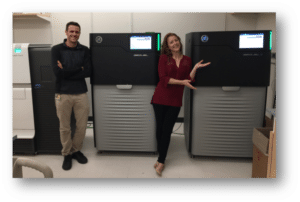
In this blog miniseries, we’re recapping presentations from early access users of the Sequel II System. Today, we summarize Luke Tallon’s report from Maryland Genomics, a PacBio Certified Service Provider.
Like the other early access users, Maryland received 32 SMRT Cells for use in evaluating the new sequencing system. They tested them across a range of applications: continuous long-read (CLR) sequencing for humans, plants, insects, and bacteria; and HiFi mode, powered by circular consensus sequencing, for human, microbiome, and other samples.
Tallon reports that each SMRT Cell 8M averaged about 92 Gb of sequence data in long-read mode; for HiFi mode, that rose to an average of about 260 Gb with a unique molecular yield of more than 16 Gb and a mean quality score of Q32. Compared to the Sequel System, they saw “comparatively longer reads from long libraries,” he said. In comparisons of libraries run on both the Sequel System and the Sequel II System, his team saw a more than 10-fold increase in sequencing capacity.
Tallon also offered three vignettes to illustrate his lab’s experience with the new sequencing system. First, he reviewed results from sequencing a 16-plex microbial pool totaling about 80 Mb. The pool was run on a single SMRT Cell 8M, yielding 215 Gb of data which allowed the team to generate high-quality assemblies. Twelve of the 16 microbial chromosomes were assembled into a single contig, and all assemblies achieved at least 99.9% completeness. Based on a detailed analysis, Tallon concluded that with the Sequel II System, “we can certainly multiplex at a much deeper level than this.”
Next, he presented data from full-length 16S amplicon sequencing, which provides more precise taxonomic information than conventional short-amplicon 16S profiling. Using HiFi mode, Tallon’s team ran two sets of 96-plex 16S amplicon libraries consisting of mock communities and infant gut samples. The resulting data had quality scores as high as Q80, with no degradation seen at the 3’ end. After demultiplexing the data, the team had a mean of ~12,000 HiFi reads per sample; 87% of those reads could be assigned to a species-level identification, and in some cases even sub-species level assignment was possible. In addition, the Sequel II System data was able to more faithfully recapitulate the composition of the mock community sample compared to a short-amplicon approach, showing the advantage of full-length 16S sequencing with the Sequel II System.
Finally, Tallon showed results from metagenome shotgun sequencing of five vaginal microbiome samples with the goal of assembling complete genomes. Despite having limited starting material and significant host contamination, Tallon reports, “we were still able to assemble complete genomes” — including for the uncultureable bacterial strain known as BVAB1 for which no reference genome previously existed. BVAB1 is a Clostridiales species linked to poor outcomes when present in the female reproductive tract.
For more details, watch Tallon’s full presentation:
Maryland Genomics is currently offering a SMRT Grant to explore metagenomes in high resolution using their Sequel II System. Submit your 250 word proposal by August 2 for a chance to win! They will also be exhibiting at ASM Microbe 2019 in San Francisco kicking off today – visit them at booth 861.
To learn more about users’ experience with the Sequel II System, check out our summary of Kiran Garimella’s presentation on how it performed at the Broad Institute.
June 20, 2019 | Infectious disease research